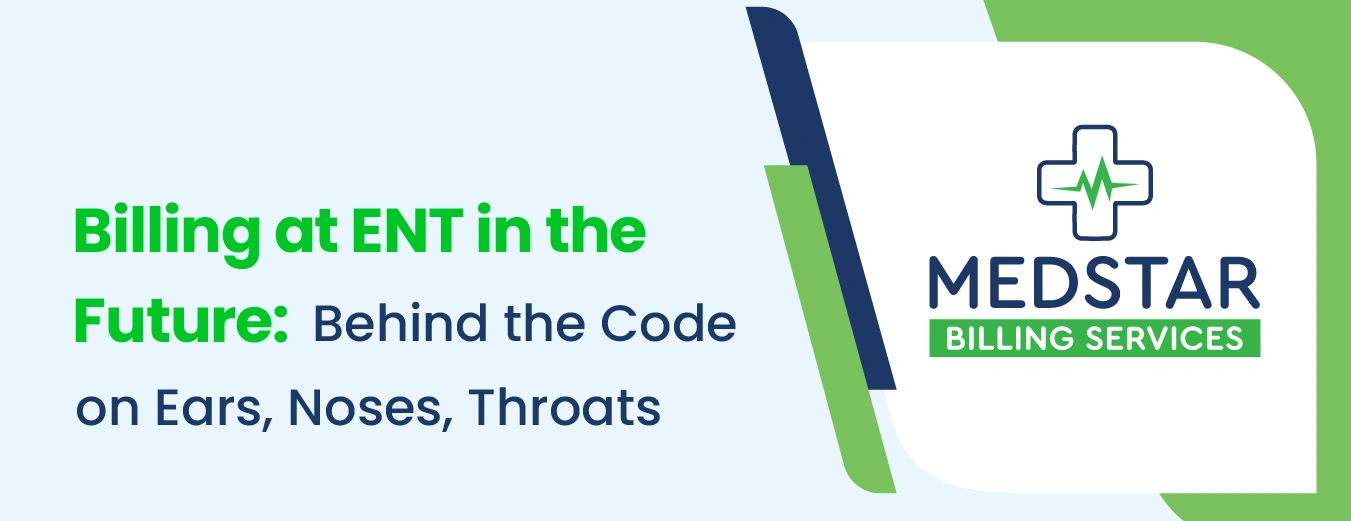In the case of ENT (Ear, Nose, and Throat) practices, behind the scenes, the ENTs usually tend to have very complex ways of billing and coding, as most of the general populace might suppose. It is not all about the stethoscopes and scopes anymore; it is all about CPT codes, ICD-10 options, and keeping in touch with the shifting and changing reimbursement rules. ENT specialists deal with everything from sinusitis to complex head and neck surgeries, and the billing process has to accurately reflect that complexity for practices to stay financially healthy.
So, what’s changing in 2025? And how do ENT providers ensure they’re paid fully and fairly?
What Is on ENT Billing in 2025?
The year 2025 has witnessed changes in both the process and the reimbursement system of otolaryngology care.
The major updates in 2025 on ENT Billing are listed
as below:
| Change | Description |
| New CPT Codes | Novel bundled codes for the endoscopic procedures of the nose with image-assisted guidance |
| Modifier Guidelines | Stricter use of modifiers -25 and -59; documentation must strongly support the separate service |
| ICD-10 Updates | New codes for chronic eustachian tube dysfunction and post-COVID-related anosmia |
| RVU Adjustments | Reimbursement reductions for routine procedures (like nasal debridement), increases for complex reconstructions |
Practices must scrutinize every CPT and ICD-10 pairing to avoid denials and optimize payments. Let’s look at the common codes next.
CPT Codes Commonly Used in ENT Billing
ENT procedures cover everything from minor office visits to intricate surgeries. Here are the most commonly used CPT codes in ENT:
| CPT Code | Description |
| 99204 | New patient visit, moderate complexity |
| 31231 | Nasal endoscopy, diagnostic, unilateral, or bilateral |
| 31575 | Flexible laryngoscopy |
| 69436 | Tympanostomy (ear tubes) with general anesthesia |
| 42820 | Tonsillectomy and adenoidectomy, under age 12 |
| 92557 | Comprehensive audiometry (hearing test) |
| 31237 | Nasal/sinus debridement after surgery |
| 92567 | Tympanometry (middle ear test) |
| 31500 | Emergency endotracheal intubation |
Coding Tip: Modifier -50 (bilateral) or modifier -59 (distinct procedural service) is usually needed when providing ENT procedures. Apply modifiers properly, or you do not get the right pay, or it can be denied.
The Commonly Paired ICD-10 Codes with ENT CPTs
Medical necessity is promoted with
proper diagnosis coding. Some of the frequently used ICD-10 codes in the ENT billing are as follows:
| ICD-10 Code | Description |
| J01.90 | Acute sinusitis, unspecified |
| H65.3 | Chronic serous otitis media |
| R09.81 | Nasal congestion |
| R43.0 | Anosmia (loss of smell) |
| J31.0 | Chronic rhinitis |
| J35.03 | Hypertrophy of tonsils with adenoids |
| H90.3 | Sensorineural hearing loss, bilateral |
| R49.0 | Dysphonia (voice disorders) |
Coding Tip: Don’t just use symptom codes—tie them to underlying conditions when known. For instance, R09.81 (nasal congestion) should be linked with a sinusitis code if applicable.
ENT Practices Common Billing Pitfalls
There are such subtle issues with billing ENT services
. These include:
- Scopes are not fully documented or under-documented of time, complications, or use of scopes
- Also, through the inappropriate use of modifiers, mainly bilateral procedures or staged processes.
- Bundling errors—claiming separately for services included in a global surgical package
- Mismatch between CPT and ICD-10 codes, leading to denials of medical necessity
Avoiding these requires training and tight coordination between clinical and billing staff.
Pro Tip: For nasal endoscopy (CPT 31231), always document laterality and indication. This helps support medical necessity when insurers request justification, especially when billed multiple times per year.
ENT Billing in 2025: Mastering Documentation, Modifiers & Procedure Settings
The Power of Documentation: What You Must Include
Whether you’re billing for a nasal endoscopy, tympanometry, or tonsillectomy, documentation is your armor. Without it, you’re exposed to denials, downcoding, and audits.
What payers expect in 2025:
- Detailed medical necessity: Why the service/procedure was required. Vague phrases like “follow-up” or “routine care” don’t cut it anymore.
- Laterality & frequency: Especially for bilateral services and repeat visits.
- Clear connection between diagnosis and service: Ensure ICD-10 codes align directly with the service provided.
- Procedure details: Tools used, anesthesia, image guidance, and extent of the procedure must be included.
Example: If billing 31237 (nasal debridement post-surgery), document:
“Status post FESS, Day 10. Thick crusting was noted in the right middle meatus. Extensive debridement performed under endoscopic guidance with suction and forceps.”
Navigating the Modifier Maze in ENT Billing
Modifiers are small but mighty—they change how services are interpreted and reimbursed. ENT practices use modifier -25, -59, -50, and -51 more than most specialties. But beware: 2025 policies demand clearer justification when these are used.
| Modifier | Meaning | Use Case in ENT |
| -25 | Separate E/M on the same day as the procedure | Used when the E/M visit was distinct and not bundled with a minor procedure like nasal cautery |
| -59 | Distinct procedural service | Used when performing unrelated endoscopic and laryngoscopic procedures |
| -50 | Bilateral procedure | Use with nasal endoscopy or myringotomy performed on both sides |
| -51 | Multiple procedures | Apply when performing two or more surgical procedures in one session |
| -52 | Reduced services | Used if a procedure is partially completed (e.g., partial polypectomy) |
Modifier Tip: Use -25 only if the E/M service led to the decision for the procedure, not just if you talked to the patient. Always document what was evaluated, assessed, and decided separately.
A Difference between Billing Office and Surgical Procedures: Major Difference
ENT practices are usually amalgamated with clinical assessments, office-based processes, and hospital operations. Different billing depends on the setting and complexity:
| Setting | Billing Notes |
| Office | Frequently contemplates E/M diagnostic scopes/audiology lab tests. Apply global period rules on minor procedures in the office. |
| ASC (Ambulatory Surgery Center) | ENT surgeries like tonsillectomies, septoplasties, and sinus surgeries are often performed here. Use an appropriate facility and professional billing. |
| Hospital | Include pre-op and post-op notes, surgical report, and anesthesia documentation. Apply global surgical package rules. |
Pro Tip: Don’t bill 99213 (E/M) and 31231 (nasal endoscopy) together without clear documentation supporting the decision for a separate evaluation. This is a red flag for audits in 2025.
ENT Billing Tip of the Day
Audit-proof your claims by using a checklist for every modifier. Before adding -25 or -59, ask:
- Is there clear documentation of a separate service?
- Is the procedure minor (0-10 global days)?
- Would the visit still be billable even if the procedure didn’t happen?
These steps will keep your ENT claims cleaner and reimbursement faster.
Billing in 2025: Surgical Coding Reality in 2025: Billed Surgical Reality in 2025: Reimbursement Coding Surgery
In the case of ENT, most of the providers base their primary source of revenue on the surgical services. ENT surgeons carry out procedures such as tonsillectomies, septoplasties, and more often than not, intricate, multi-layered, and high-stakes procedures. However, in 2025, ENT surgery billing will not be all about clinical perfection: it is also a matter of coding and RVUs.
Under the new reimbursement models and RVU readjustment, your reimbursement relations will literally determine how well your clinic or surgical group is managing its finances. So, what is the riddle of the present ENT surgery?
Common ENT Surgical Procedures and CPT Codes
Here’s a list of high-frequency surgical procedures ENT specialists perform, along with their updated CPT codes:
| CPT Code | Description |
| 42826 | Tonsillectomy, age 12 and over |
| 30520 | Septoplasty, surgical repair of the nasal septum |
| 31254 | Endoscopic ethmoidectomy, partial |
| 31267 | Nasal/sinus endoscopy with maxillary antrostomy |
| 31579 | Laryngoscopy with stroboscopy |
| 42820 | Tonsillectomy and adenoidectomy, under age 12 |
| 69436 | Tympanostomy with general anesthesia |
| 30140 | Submucous resection of the inferior turbinate |
Coding Insight: ENT surgeries often involve multiple anatomical regions. Always capture every distinct service using appropriate modifiers (-59, 51), and watch for bundling edits in NCCI (National Correct Coding Initiative) guidelines.
Reimbursement Rates in 2025: Winners and Losers
ENT billing did not adapt well to a couple of surprises with the Medicare Physician Fee Schedule (MPFS) of 2025. Because of RVU recalibration, CMS made a small decrease in reimbursement of some routine sinus procedures but raised payment in complex nasal reconstructions and voice-related procedures.
Here’s a snapshot:
| Procedure | 2024 Avg Medicare Reimbursement | 2025 Updated Reimbursement | Change |
| 42820 (T&A <12 yrs) | $530 | $512 | ⬇️ -3.4% |
| 30520 (Septoplasty) | $645 | $612 | ⬇️ -5.1% |
| 31254 (Ethmoidectomy) | $720 | $699 | ⬇️ -2.9% |
| 31579 (Stroboscopy) | $168 | $195 | ⬆️ +16% |
| 30140 (Turbinate Reduction) | $490 | $505 | ⬆️ +3.1% |
Key Takeaway: ENT practices focusing on voice disorders, airway management, and surgical reconstructions will benefit most from the 2025 RVU shifts. Those relying heavily on routine sinus procedures may see decreased margins unless they optimize billing processes.
The RVU Breakdown: Understanding the Math
Relative Value Units (RVUs) are the foundation of Medicare’s payment formula. In 2025, ENT codes were re-evaluated based on time, complexity, and post-op care.
Each CPT code’s payment =
(Work RVU + Practice Expense RVU + Malpractice RVU) × Conversion Factor
In 2025, the conversion factor dropped slightly from $33.89 to $33.51, contributing to reimbursement cuts.
Let’s look at an example:
| CPT Code | Work RVU | Total RVU | 2025 Payout |
| 31267 | 4.65 | 7.21 | $241.74 |
| 42826 | 4.19 | 6.78 | $227.25 |
| 31500 | 2.31 | 3.78 | $126.71 |
Tip: Use RVUs to benchmark provider productivity and forecast revenue. ENT practices using EHR-integrated billing tools with RVU analytics tend to capture more revenue accurately.
ENT Surgical Coding Tips
- Don’t forget global periods: Most ENT surgeries have 90-day global periods. Be cautious when billing follow-ups or minor procedures post-op.
- Always include op notes: Surgeons must document exact procedure, anatomical details, laterality, and intraoperative findings.
- Use image guidance codes wisely: If using intraoperative CT or navigation (e.g., during endoscopic sinus surgery), add 61782 (stereotactic guidance) if payer allows.
Tip: Add value with accurate assistant surgeon modifiers: In ENT cases like parotidectomy or complex sinus surgeries, assistants may be required. Append modifier -80 (assistant surgeon) and ensure the payer policy covers it. Don’t leave revenue on the table.
ENT Billing in 2025: Real Claims, Bundling Clarity & Denial Survival
So far, we’ve covered coding, documentation, and reimbursement rates—but where things really get tricky (and interesting) is in the actual billing workflow. ENT claims often trigger denials because of bundling issues, prior authorization lapses, and incorrect coding combinations.
We can now decipher situations that ENT billers encounter in their day-to-day life and transform them into success stories.
Scenario 1: Nasal needlescope + E/M = Denial?
Real-World Example:
It is a case involving a patient who has chronic sinusitis. On the same day, the ENT uses a complete E/M exam (99213) and a nasal endoscopy (31231). The biller enters the two codes, but has the E/M service rejected as being included.
What did not happen?
Lack of sufficient documentation as to the modifier -25.
The remedy to it:
- Clearly document a separate history, exam, and decision-making beyond what’s required for the procedure.
- Use modifier -25 on the E/M code: 99213-25.
Pro Tip: Avoid copy-pasting “separate E/M service” in your notes—payers are flagging these for audits in 2025. Make your note unique and specific.
Scenario 2: Endoscopic Sinus Surgery with Multiple CPTs
Let’s say your ENT surgeon performs:
- Total ethmoidectomy (31255)
- Maxillary antrostomy with tissue removal (31267)
- Frontal sinusotomy (31276)
You bill all three, but get a denial for 31267.
What happened?
NCCI edits flagged 31267 as potentially bundled with 31255. The claim lacked a modifier.
Billing Fix:
- Append modifier -59 to the distinct procedure: 31267-59.
Reminder:
Always consult the Medicare NCCI edit tables or use billing software with automated edit checking before submitting claims.
ENT Billing Pitfalls that Come Up in Prior Authorization
By 2025, prior authorization is going to be clamped down on by the private payers in the following areas:
- In-office balloon sinuplasty (e.g., CPT 31295-31297)
- immunotherapy (95165) and allergy testing (95004)
- ENT-related sleep study/sleep apnea intervention
- Adults or non-recurrent tonsillectomy
Tips to Navigate:
| Step | Action |
| 1 | Verify medical necessity policies by payer |
| 2 | Include photographic or imaging evidence in documentation |
| 3 | Document impact on quality of life—many payers require proof of functional impairment |
| 4 | Submit all CPTs planned for the session in the prior auth request |
Never assume prior auth approval = payment. You must still submit a clean claim with full documentation to support the necessity.
Common Denials in ENT and How to Beat Them
| Denial Reason | Cause | Resolution |
| Bundled services | Two CPTs reported without a proper modifier | Check NCCI edits and use -59 or -XS |
| Global period violation | Billing post-op care separately | Flag all surgeries with their global period and adjust your billing calendar |
| Invalid diagnosis | CPT doesn’t match ICD-10 | Use diagnosis lookup tools or coding crosswalks |
| No prior authorization | Services performed before approval | Appeal with urgency notes and a retrospective approval request |
| Documentation not submitted | Payers need op reports, scope notes | Attach clinical notes with the initial claim or in the first-level appeal |
ENT Tip: Create billing “cheat sheets” for each ENT provider in your practice. Include their most-used codes, typical modifiers, and payer-specific rules. Update these monthly based on denials and policy changes.
It’s a small step that significantly reduces errors and claim rejections.
ENT Billing in 2025: Final Tips, FAQs & What’s Next
ENT Billing FAQs
- Can we bill an E/M code with an in-office procedure like flexible laryngoscopy (CPT 31575)?
Yes, but only if a separate and significant E/M service was performed and modifier -25 is appended. Ensure documentation clearly supports this.
- Is a nasal endoscopy (31231) billable more than once in a year?
Yes, but it must be medically necessary each time. Payers may flag high frequency, document clinical findings and purpose every time.
- How do we bill for bilateral procedures like ear tubes or nasal surgeries?
Use modifier -50 for bilateral procedures on the same CPT line, unless the payer prefers units × 2 or two lines with modifiers -RT and -LT. Always check payer-specific preferences.
- Do we need prior auth for allergy testing in 2025?
Yes, for many commercial plans. CPT codes like 95004 (skin tests) and 95165 (allergy serum) are under stricter review in 2025 due to abuse patterns. Always check before delivering the service.
- Why are we getting denials for bundled sinus surgery codes?
The NCCI edits flag some sinus surgery CPTs as mutually exclusive or bundled unless medically distinct. Use modifier -59 (or -XS) with full intraoperative notes to unbundle when appropriate.
Must-Have Tools for ENT Billing in 2025
| Tool | Purpose |
| NCCI Edit Checker | Prevent claim rejections from bundled procedures |
| RVU Tracker | Monitor provider productivity and optimize procedure mix |
| ICD-10 Crosswalks | Match diagnoses with billable procedures for clean claims |
| EHR-Billing Integration | Ensure accurate CPT & ICD transfer from charting |
| Eligibility & Auth Portal | Real-time verification of coverage and prior auth needs |
| Claim Scrubber Software | Catch errors before submission—boosts clean claim rate significantly |
Top Tips for ENT Billing Teams
- Weekly denial huddles: Identify patterns and solve recurring issues
- Payer policy folders: Keep a central library of rules for quick reference
- Custom ENT templates: Pre-set note structures in your EHR for common procedures
- Monthly training refreshers: Stay on top of RVU and code updates
- Appeal like a pro: Track denial reasons and aggressively appeal with strong documentation
Tip of the Day: “If you’re billing it, you should be able to explain it in 30 seconds.” That’s how bulletproof your documentation should be.
What’s Next for ENT Billing?
ENT billing is expected to lean further into automation, AI-based claim scrubbing, and real-time coding assistance by 2026. But don’t wait for tech alone. The best ENT billing teams in 2025 are already:
- Point of care
coding
- Documentation and revenue cycle
correspondence
- Internal pre-auditing before the payer can audit them
Get ready to enter the age of reimbursement based on outcomes of ENT, much like it is in other specialties. Clinics that are accurate, transparent, and tech-savvy in making their bills will prosper.
Final Thoughts
ENT billing has now become more than just submitting codes; it is more of creating a system where your practice will not experience any leakage of finances due to a lack of compliance and reduced reimbursement. As an ENT surgeon, biller, and a clinic manager, it would lax 2025 to offer a mix of coding expertise, program sophistication, and billing technique.
You’ve now got a blueprint—one that will keep your claims clean, your reimbursements strong, and your ENT practice future-ready. In order to get detailed and updated information about medical coding and billing, go through other articles on the website, and don’t forget to call “Medstar Billing Services” to get a 100% accurate reimbursement for your services.





